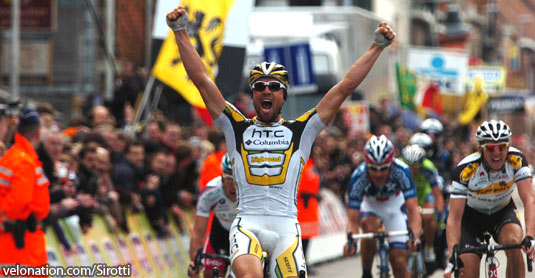
Bernhard Eisel outsprinted his five breakaway companions to take a deserved win in Gent-Wevelgem. He beat Sep Vanmarcke and Philippe Gilbert decisively. George Hincapie, who launched the sprint with a little more 300m to go, ended in fourth place, ahead of Daniel Oss and Jürgen Roelandts.
The winning break formed at the second and final climb of the Kemmelberg, almost 40km from the finish. Initially, the move was ten riders strong, but Matti Breschel flatted and dropped back to the chase group. Then tactical maneuvers broke up the break further, eliminating another danger man in former Gent-Wevelgem winner Oscar Freire.
Eisel was glad he studied the course well. “It was the right decision to not participate in the E-3 Harelbeke Classic,” eisel said after the race.
“Today we were rested and in good shape, we knew what was coming up and we were ready to go. My teammates really helped to put me in a great position for the win. Matt Goss and Hayden Roulston are two names I’d like to mention but everybody did a great job.”
It was Eisel’s biggest career win so far. “Winning stages in the Tour of Switzerland was good, and leading there was something very special, too. But this is Gent-Wevelgem. It’s a major Classic and it’s always been one of my biggest dreams to take a race like this. And after this, who knows what could happen in the Tour of Flanders and Paris-Roubaix?”
Eisel showed off his sprinting abilities in the end. “Bernie won it by two bike lengths,” said HTC-Columbia sports director Tristan Hoffman. “The other guys tried everything they could to get rid of Bernie because they knew he would be the fastest if it came down to a sprint, but it just wasn’t possible.”
HTC-Columbia had won the race last year with Edvald Boasson Hagen. The Norwegian now rides for Sky but had to abandon the race today. “HTC-Columbia had been on the front all day. Bernie, Marcel [Sieberg] and Matt [Goss] were all working away and keeping everything under control.”
The race was drastically changed this year, upgrading from a mid-week position to the Sunday before Flanders. “There were some new climbs before the Kemmel, which we’d checked out and ridden over on the Friday before the race,” Hoffman said. “That was where it all split apart. There were groups everywhere but Bernie stayed calm, got into the right break and then played it perfectly at the finish.”
Hincapie was the one who launched the sprint. “In hindsight, if I had waited, I would have been for sure in the first three, but I would not have been able to beat Eisel,” he said. “I’m pleased. I was very focused and concentrated all day. The team really helped me out.”
Break gets only small gap
After a few early attempts to establish a breakaway, Geert Steurs, Angel Madrazo, Tom Van den Haute and Matthé Pronk got away and had half a minute after 18 kilometers. Their gap increased only slowly and after 40 kilometers – raced in one hour – it was around one minute.
But this changed when the hills started. After the Scherenberg, the gap was at three and a half minutes, which turned out to be the maximum for the day. At the halfway point, the gap was back down to around a minute. This was the point where the peloton broke in half, with notable names like Tom Boonen and Fabian Cancellara stuck on the wrong end of the bike race.
Lars Bak demonstrated that he was strong when he went after the leaders by himself and caught them with 90km remaining.
Others decided to try their luck in small groups or solo as well. Johnny Hoogerland and Ruben Perez took off, with the latter being replaced by Roy Curvers on the climb of the Baneberg. Robbie McEwen also tried to bridge solo, but after the Kemmelberg, the peloton’s pace eliminated all these efforts.
The five riders on the front were still two minutes ahead of the splintering peloton, with some 70km to go. The second part of the peloton stepped out of the race at the feed zone, including Boonen and Cancellara.
Kemmelberg the decisive point
The splintering after the Kemmelberg was partially caused by Liquigas, which pulled hard. Freire and Philippe Gilbert were stuck with a larger second group, but eventually managed to move up. With 50 kilometers to go, the break had been caught and the two larger groups were also together again.
Maxim Iglinsky was interrupting the brief truce with 48 kilometers to go. Under his pressure, a group of eventually ten riders formed. Besides Iglinsky, there were Oss, Breschel, Freire, Hincapie, Eisel, Vanmarcke, Aleksandr Kuschynski, Gilbert and Roelandts.
Breschel was first over the final climb of the day, the second time up the Kemmelberg, but waited for his breakaway partners after the descent. A four-man group came up from behind, with Tyler Farrar, Christian Knees, Luca Paolini and Baden Cooke. They were around half a minute behind with 30 kilometers remaining.
Until 19 kilometers to go, the four looked of having a chance, with the gap as low as 23 seconds, but then it opened up again. Breschel flatted and found himself in the second group, with no more Saxo Bank riders in the lead.
The gap came back down a bit, under 20 seconds. This was in part due to the tactical games that had started in the front group, with Freire and Iglinsky the main victims.
Vanmarcke attacked shortly before the 2km banner. Roelandts paid attention and with about 1.5km everything was together for the final sprint.
2010 Gent-Wevelgem results – 217km
1. Bernhard Eisel (HTC-Columbia)
2. Sep Vanmarcke (Topsport Vlaanderen)
3. Philippe Gilbert (Omega Pharma)
4. George Hincapie (BMC)
5. Daniel Oss (Liquigas)
6. Jürgen Roelandts (Omega Pharma)